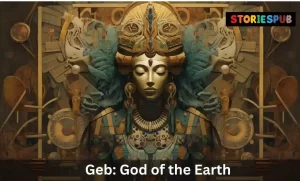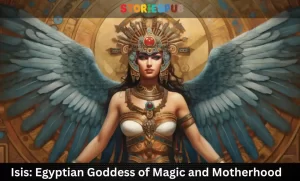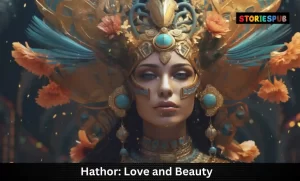.
Menhit – The goddess of war and hunting

The Overview
The ancient Egyptians believed in a pantheon of gods and goddesses that controlled every aspect of life. Among these deities, Menhit held a significant place as the goddess of war and hunting. She was known for her power, ferocity, and strength, which made her an essential figure in both the spiritual and physical realms.
As a warrior goddess, Menhit was often depicted as a fierce lioness with powerful hind legs that represented her ability to run fast and strike hard. Her sharp claws and teeth symbolized her strength in battle.
Menhit was also associated with the color red because of its association with bloodshed on the battlefield. Menhit’s role in Egyptian mythology was not limited to warfare alone; she also played an important part in hunting.
Her ability to hunt down prey was seen as an essential quality for any warrior or hunter who wanted to succeed. Hunting rituals were often performed to honor Menhit before going out on expeditions.
The Importance
Menhit’s importance in Egyptian mythology cannot be overstated. As one of the most significant deities associated with war, she played a vital role in protecting pharaohs during battles against their enemies. She was often invoked by soldiers before going into battle for protection and victory.
In addition to being a protector of pharaohs, Menhit was also regarded as the patroness of warriors who embodied bravery, courage, and strength on the battlefield. The ancient Egyptians believed that those who worshipped Menhit would be granted victory over their enemies.
Furthermore, Menhit’s association with hunting made her an important deity for those who relied on hunting for survival or as a source of food. Hunters would often invoke her name before embarking on hunts to ensure success.
Menhit’s importance lies not only in her role as a goddess of war and hunting, but also in the qualities she embodied. Her power, ferocity, and strength made her an ideal deity for those seeking protection and victory in both warfare and hunting.
Origins and Mythology
Menhit’s Origins as a Local Deity in Upper Egypt
Menhit was originally worshiped as a local goddess in Upper Egypt, specifically in the city of Esna. Her name means “she who massacres” or “she who slays,” which reflects her association with war and combat.
As the cult of Menhit grew, she became more widely recognized throughout Egypt. While Menhit was primarily worshiped as a goddess of war and hunting, she also had other associations.
For example, she was sometimes depicted alongside the god Thoth, who was associated with wisdom and knowledge. This suggests that Menhit may have also been associated with mental prowess and strategic thinking.
Her Association with the Lioness, a Symbol of Strength and Ferocity
One of Menhit’s most notable attributes was her association with the lioness. This powerful animal symbolized strength, ferocity, and protection – all qualities that were valued highly in ancient Egyptian culture. In some depictions of Menhit, she is shown wearing a headdress adorned with lion ears and plumes.
The lioness imagery is particularly significant when considering Menhit’s role as a protector of pharaohs and warriors. Just as a lioness would fiercely defend her cubs from any threat, Menhit stood ready to defend her devotees against their enemies.
Role in Battles as a Protector of Pharaohs and Warriors
In addition to being associated with hunting, Menhit played an important role in battles as well. As mentioned earlier, she was regarded as a protector of pharaohs and warriors alike – those who were seen as holding important positions within society. During times of conflict or war, prayers would be offered to Menhit for protection on the battlefield.
Soldiers might even carry images or amulets of the goddess with them into battle, hoping to gain her favor and protection. In this way, Menhit served as a symbol of strength and courage for those who fought in the name of Egypt.
Overall, Menhit’s origins and mythology are rich with symbolism and meaning. As a goddess associated with both war and hunting, she embodied some of the most important values and qualities that were valued by ancient Egyptians.
Worship and Rituals
Temples dedicated to Menhit throughout Egypt
Menhit was widely worshipped throughout ancient Egypt and was associated with many temples. Some of the most famous temples dedicated to her were located in the cities of Thebes (modern-day Luxor), Hermonthis (modern-day Armant), and Kom Ombo.
These temples were built during the New Kingdom period, between 1550 BCE and 1069 BCE. The temple in Thebes, known as Medinet Habu, was particularly important because it was considered a royal temple.
It was built by pharaoh Ramses III who dedicated it to Amun, Mut, and Khonsu as well as Menhit. The temple was used for both religious purposes and as a military fortress.
Another famous temple dedicated to Menhit is the one in Kom Ombo which dates back to the Greco-Roman period. It is unique because it is a double temple dedicated to two sets of gods – Horus the Elder and Sobek on one side, and Haroeris (Horus the Younger) with his consort Tasenetnofret on the other side.
Offerings made to her during times of war or before hunting expeditions
Menhit was considered a protective goddess who had power over life and death. As such, offerings were regularly made to her by soldiers before going into battle or by hunters before embarking on a hunt.
Offerings typically consisted of food items such as bread, fruits, vegetables, meat, beer or wine. In addition to physical offerings made at altars or shrines dedicated to her within temples or homes, people also offered up their prayers for protection in battle or success during hunting expeditions.
Rituals performed to honor her including dance and music
Rituals were performed to honor Menhit and show devotion to her. These rituals usually consisted of dance and music performances, as well as the recitation of hymns and prayers.
Dancers would often wear lion masks or costumes to embody the ferocity and strength that Menhit was associated with. Drums, sistrums, flutes, and other musical instruments were also used during these performances.
In some cases, people would also participate in processions where they carried statues of Menhit through the streets of their cities or villages. These processions were usually held during festive occasions such as the Opet Festival which was celebrated annually in Thebes.
Overall, Worship and Rituals played an important role in the lives of ancient Egyptians who sought protection from their gods, especially before going into battle or embarking on dangerous hunting expeditions. Menhit’s association with war and hunting made her a popular deity among soldiers and hunters alike who looked up to her for guidance and protection.
Relationships with Other Deities
As a goddess of war and hunting, Menhit was often associated and identified with other deities in the ancient Egyptian pantheon. One of her closest relationships was with Montu, the falcon-headed god of war who was worshipped primarily in Upper Egypt. Montu was often depicted as a fierce warrior, wielding a spear or sword in battle.
Together with Menhit, they formed a powerful duo of war deities who protected pharaohs and their armies. Another deity that Menhit had close ties to was Sekhmet, the lioness-headed goddess of warfare as well as healing.
Sekhmet and Menhit were both strong female figures associated with the lioness, which made them natural allies on the battlefield. However, unlike Sekhmet who had a reputation for being destructive and bloodthirsty, Menhit was known for her protective nature towards those she deemed worthy.
Association with Montu
The association between Menhit and Montu went beyond just sharing similar aspects of war and protection. In some myths, it is said that they were married or siblings – either way their relationship highlights their importance in Upper Egypt where they were both worshipped heavily. Their presence can be seen in many temples throughout Upper Egypt such as The Temple of Karnak where there is an area dedicated to both deities known as the “Montu-Mut-Menhet Triad.” This triad combined the power of Montu’s military might with Mut’s motherly nature (Mut being an important mother goddess) and Menhet’s protective nature to create an all-powerful force.
Relationship with Horus
In addition to these relationships, Menhit also shared an association with Horus – another important god in Egyptian mythology. Horus was a sky god who was often depicted as a falcon or hawk, and he too was associated with hunting. However, unlike Menhit who represented the physical aspects of hunting – such as tracking and killing prey – Horus was seen more as a divine force that aided hunters in their endeavors.
One example of their association can be seen in the myth of “The Contendings of Horus and Seth,” where Menhit is called upon to aid Horus in his battle against his uncle Seth. She provides him with weapons and helps him to overcome his opponent, demonstrating her importance as a protector and ally to other deities.
Legacy
The legacy of Menhit can be seen in many aspects of Egyptian art and culture. Her depiction as a fierce warrior goddess influenced later depictions of female warriors such as the goddess Neith, who was also associated with hunting. In addition, her protective nature towards pharaohs paved the way for later deities such as Wadjet – the goddess of protection – who became an important figure in ancient Egyptian religion.
Today, some practitioners of Kemetic religion still honor Menhit as an important deity within their pantheon. They perform rituals and offer prayers to her for protection during times of war or danger, highlighting how her legacy lives on even in modern times.
Menhit’s relationships with other deities highlight her importance not only as a goddess of war and hunting but also as a protector and ally to other gods. Her legacy continues to influence Egyptian mythology and religion today, solidifying her place among the pantheon of powerful deities worshipped by ancient Egyptians.
Influence on Later Depictions of Female Warriors in Egyptian Art
Menhit’s depiction as a fierce and powerful warrior had a lasting impact on how female warriors were portrayed in ancient Egyptian art. Prior to Menhit’s rise to prominence, female deities were often depicted in more passive or nurturing roles, such as mothers or wives.
However, Menhit’s association with war and hunting helped to shift the perception of women in ancient Egypt and paved the way for future depictions of female warriors. One notable example is the goddess Neith, who was also associated with war and hunting.
Like Menhit, Neith was often depicted wearing a crown of two crossed arrows – a symbol of her role as protector and defender. However, unlike Menhit who was primarily worshipped in Upper Egypt, Neith had a larger following throughout the country and eventually became one of Egypt’s most popular goddesses.
Another example is the goddess Bastet, who was originally associated with fertility but later became associated with warfare during periods of conflict. In some depictions, she appears wielding weapons such as bows or spears – a clear nod to Menhit’s influence on how female deities were portrayed.
Continued Worship by Some Modern Practitioners of Kemetic Religion
While ancient Egyptian religion may no longer be widely practiced today, there are still those who honor Menhit as part of their spiritual practice within the framework of Kemetic religion. This modern form of Egyptian religion seeks to reconstruct the beliefs and practices of ancient Egyptians using historical research and personal gnosis.
For followers of Kemetic religion who honor Menhit, she is typically viewed as a powerful protector who can offer guidance during times of struggle or conflict. Some practitioners may perform offerings or rituals dedicated to her specifically during times when they need extra strength or courage.
It should be noted that not all Kemetic practitioners incorporate Menhit into their personal practice, as there is no one-size-fits-all approach to this modern form of Egyptian religion. However, for those who do honor her, Menhit remains an important figure in their spiritual journey – a reminder of the strength and power that can be found within oneself.
Menhit’s legacy as a goddess of war and hunting in ancient Egyptian mythology is one that has endured throughout the centuries. From her origins as a local deity in Upper Egypt to her eventual rise to prominence throughout the country, Menhit’s association with strength and ferocity helped to pave the way for future depictions of female warriors in Egyptian art.
Today, while ancient Egyptian religion may no longer be widely practiced, Menhit continues to be honored by some modern practitioners of Kemetic religion. For these individuals, she remains a symbol of courage and protection – a reminder that even in times of struggle or conflict, one has the power within themselves to overcome adversity.
Conclusion
Menhit was a revered goddess in ancient Egyptian mythology due to her association with war and hunting. Her origins as a local deity in Upper Egypt eventually led to her worship throughout the entire kingdom, including the construction of temples dedicated to her. As the protector of pharaohs and warriors during times of battle, Menhit played an important role in ancient Egyptian society.
Additionally, her association with the lioness and other powerful animals served as symbols of strength and ferocity that were highly valued by the Egyptians. Menhit’s legacy can still be felt today through her influence on depictions of female warriors in Egyptian art.
Her continued worship by some modern practitioners of Kemetic religion is a testament to her enduring importance within this cultural tradition. Overall, Menhit’s significance as a goddess of war and hunting cannot be overstated.
Her powerful presence in ancient Egyptian mythology represents an important aspect of their culture’s values and beliefs. Through continued study and appreciation for figures like Menhit, we can gain insight into the rich history of this fascinating civilization.
Hey kids, how much did you like Menhit – The goddess of war and hunting? Please share your view in the comment box. Also, please share this story with your friends on social media so they can also enjoy it, and for more such Egyptian Mythology, please bookmark storiespub.com.
Related Post :
Menhit FAQ
What was Menhit's primary role in ancient Egyptian mythology?
Menhit's primary role was as the protector of the king and the defender of the kingdom. She was believed to help the king in battle, as well as protect the kingdom from external threats.
How is Menhit related to other Egyptian deities?
Menhit is often associated with the god Horus, particularly in his role as the protector of the king. She is also connected to the goddess Sekhmet, another lioness-headed deity associated with war and protection.
What are the primary symbols associated with Menhit?
Menhit is often depicted as a lioness or a woman with the head of a lioness, symbolizing her strength, power, and agility. She is also associated with the spear, reflecting her role in battle and hunting.
How was Menhit worshiped in ancient Egypt?
Menhit was worshiped through prayers, offerings, and rituals intended to appease her and seek her protection. She was often invoked during times of war or threat, as well as during hunting expeditions.
Are there any temples dedicated to Menhit in ancient Egypt?
There are no known temples specifically dedicated to Menhit, but she was often featured in other temples associated with the protection of the king and the defense of the kingdom.
Were there any specific rituals or festivals associated with Menhit?
While there are no specific festivals or rituals dedicated to Menhit alone, she was often invoked during ceremonies related to warfare, hunting, and the protection of the king.
What is the symbolism behind Menhit's depiction as a lioness or a woman with a lioness's head?
The lioness symbolizes Menhit's strength, power, and agility, as well as her role in battle and hunting. As a protector of the king, she was believed to possess these qualities to help defend the kingdom.
How did the worship of Menhit change over time?
As Egyptian society evolved and the role of the king changed, the worship of Menhit became less central. However, she continued to be invoked for protection and guidance, particularly in times of war or danger.
Can I still find representations of Menhit in modern times?
Yes, representations of Menhit can still be found in museums, art collections, and books about ancient Egypt. Her image also appears in popular culture, particularly in media related to ancient Egyptian mythology and history.



